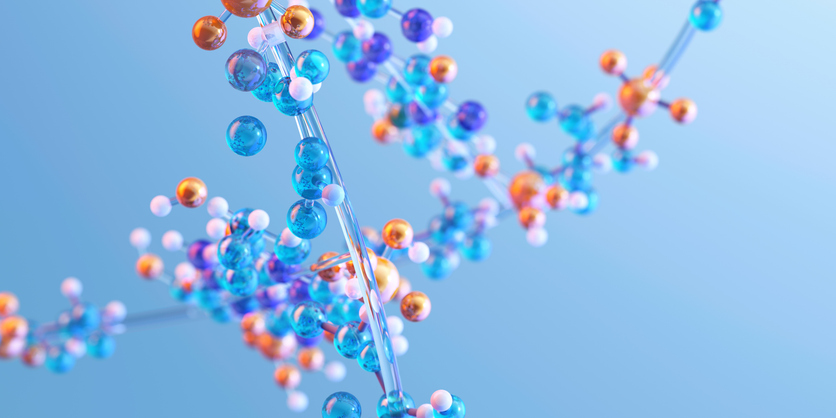
Peptides may be small in size, but they have a massive impact on biological research and pharmaceutical innovation. At their core, peptides are short chains of amino acids that exhibit remarkable specificity and versatility, often functioning as hormones, enzymes, or signaling molecules in living organisms.
Here at Adesis, we see firsthand how a deep understanding of peptide structure can accelerate advancements in therapeutics, diagnostics, and beyond. Next, we’ll dissect the intricacies of peptide structures, explore their many roles in biological systems, and highlight commercial and medical applications. Then, we’ll share a glimpse into how our expertise can support your work at the conclusion of this overview. Learn more about the science behind peptides and their applications below. Then, contact us to speak to our team.
Peptide Basics and Structural Significance
Peptides are formed when two or more amino acids link together via peptide bonds. These covalent bonds occur between the carboxyl group of one amino acid and the amino group of another, releasing a molecule of water in the process. The resulting chain can vary from just a couple of amino acids up to several dozen. Once a sequence surpasses 50 amino acids or so, it’s often classified as a polypeptide or protein, but there’s no strict cutoff.
Researchers devote considerable effort to studying how each amino acid sequence folds, binds and interacts within its environment. A slight alteration in chain length, amino acid composition, or side-chain modification can dramatically affect a peptide’s stability and function.
Peptide Bond Formation
The peptide bond is deceptively simple yet foundational to protein chemistry. This amide linkage is rigid and planar, imposing certain constraints on how each amino acid can rotate or tilt relative to its neighbors. Despite these constraints, peptides can still adopt local folding patterns, such as alpha-helices and beta-sheets, similar to larger proteins. Even short peptides can exhibit subtle secondary structures that determine how they interact with targets like receptors or enzymes.
Primary, Secondary, and Tertiary Structures
Peptides are often mentioned as having primary, secondary, and tertiary structures. The main differences between these structures include:
- Primary Structure: This is the exact amino acid sequence, essentially, the linear arrangement of residues. Each amino acid’s side chain contributes to the peptide’s chemical properties, from polarity to charge.
- Secondary Structure: Short peptides can form local motifs like alpha-helices and beta-sheets, although they typically do so to a lesser extent than full-size proteins. These structures are held together by hydrogen bonds between backbone amides.
- Tertiary Structure: While classic tertiary folding is more common in larger proteins, some peptides fold into distinct three-dimensional shapes. Specific folds can facilitate specialized tasks, such as binding to a particular surface on a cell or catalyzing a reaction.
The roles of the primary, secondary, and tertiary structures can vary depending on the nature of the amino acids involved. Then, the nature of these structures influences the biological processes peptides impact.
Functional Attributes Across Biology
Peptides serve as essential components in countless physiological processes. They can act as messengers traveling through the bloodstream, local mediators within a tissue, or scaffolding materials that assemble into functional complexes. This versatility is one reason researchers across many disciplines continually investigate the potential of peptides to tackle medical and scientific challenges.
Signaling and Regulatory Roles
Much like hormones, many peptides function as signaling molecules. They’re produced in one region of the body and transported to target cells, where they bind receptors and trigger cascades of cellular events. Insulin and glucagon, for instance, are well-known peptide hormones crucial for regulating blood glucose levels. Similarly, neuropeptides in the brain influence everything from mood to stress responses.
Enzymatic Activity in Metabolic Pathways
Some peptides, particularly those on the cusp of being classified as small proteins, serve as enzymes. These catalytic peptides accelerate reactions that would otherwise be too slow to sustain life. By altering their active sites or substrate binding regions, scientists can fine-tune these peptide enzymes for specific industrial or therapeutic processes. This targeted approach is particularly useful when designing specialized catalysts, like those used for environmentally friendly chemical synthesis or wastewater treatment.
Commercial and Therapeutic Applications
Peptides occupy a sweet spot between traditional small-molecule drugs and full proteins: they’re relatively simple to modify and synthesize but can still display high specificity and potency. This unique combination propels them to the forefront of various commercial sectors, especially within the pharmaceutical and biotech industries.
Drug Delivery Innovations
One of the most promising applications involves using peptides as drug-delivery vehicles. By attaching therapeutic payloads, such as cytotoxic drugs, nucleic acids, or imaging agents, to specific peptide sequences, researchers can improve targeted delivery to diseased tissues or cells. This approach minimizes off-target effects and enhances the therapeutic index. Peptide–drug conjugates have shown particular promise in oncology, where they can direct potent toxins to tumor cells while sparing healthy tissue.
Cosmetic and Nutritional Products
Beyond therapeutics, peptides have also been found successful in cosmetics and nutritional supplements. In skin care, peptides can promote collagen production or provide anti-inflammatory benefits. Nutritional peptides, often derived from protein hydrolysates, can support muscle recovery or metabolic regulation. Their biodegradability, coupled with high performance, makes them desirable for such consumer products, which thrive on claims of effectiveness and safety.
Techniques and Challenges in Peptide Development
Developing peptide-based applications isn’t without its obstacles. From design and synthesis to stability and scale-up, each stage demands careful planning and specialized expertise. Researchers must navigate potential hurdles like rapid enzymatic degradation and the complexities of large-scale manufacturing.
Stability Concerns
Despite their potential, peptides often degrade relatively quickly in vivo due to proteolytic enzymes in the bloodstream, stomach, or other tissues. Strategies such as encapsulation, polymer conjugation, or the incorporation of D-amino acids (which are less recognized by proteases) can extend peptide half-life. In addition, certain administration routes, like transdermal or intranasal delivery, may bypass harsh conditions, further improving bioavailability.
Large-Scale Manufacturing
Producing large quantities of peptides, especially for clinical or commercial needs, presents logistical and cost concerns. Automated solid-phase peptide synthesis (SPPS) has simplified production for shorter sequences, but longer or highly complex peptides might still face yield and purity issues. Adequate quality control is paramount: consistent batch-to-batch purity with minimal by-products, as well as strict manufacturing controls are essential to ensure safety and efficacy.
Advanced Isotopic Labeling Expertise
Adesis brings unparalleled expertise to the field of isotopically labeled peptides, offering comprehensive deuteration and C13-labeling capabilities that accelerate research workflows. Our specialized teams routinely synthesize deuterated peptides with precision placement of deuterium atoms at specific positions critical for metabolic and structural studies. This targeted labeling approach enables researchers to track peptide metabolism, binding interactions, and pharmacokinetic properties with exceptional accuracy.
The integration of C13-labeled amino acids into custom peptides further enhances research applications by creating ideal candidates for NMR spectroscopy and mass spectrometry studies. Our synthetic chemists work closely with research teams to determine optimal labeling patterns that maximize signal-to-noise ratios while maintaining biological activity. These specialized labeling services have supported groundbreaking research across pharmaceutical development, academic investigations, and clinical diagnostic applications.
Metabolic Stability Through Strategic Modification
D-amino acid substitution represents a powerful approach to enhancing peptide stability by fundamentally altering how these molecules interact with metabolic enzymes. When strategically incorporated, D-amino acids create conformational changes that sterically hinder enzymatic recognition while preserving the peptide’s active binding regions. This selective protection significantly extends half-life in biological systems, allowing therapeutic peptides to maintain efficacy for substantially longer periods compared to their L-amino acid counterparts.
Deuteration offers a complementary strategy for metabolic stabilization by exploiting the kinetic isotope effect to slow bond cleavage at critical positions. The stronger carbon-deuterium bonds require higher activation energy to break than traditional carbon-hydrogen bonds, creating a protective effect against enzymatic degradation. Adesis leverages this principle through selective deuteration at metabolically vulnerable positions, effectively creating peptides with enhanced circulation times without altering the molecular recognition properties essential for therapeutic activity. The combination of deuteration with other stabilization techniques provides a sophisticated toolkit for developing peptide therapeutics with optimized pharmacokinetic profiles.
The Development Pipeline for Peptide Therapeutics
Creating a peptide-based therapy follows a multi-step path that’s similar to traditional drug development, albeit with some unique twists. Each phase, including discovery, preclinical validation, clinical trials, and regulatory review, must be carefully coordinated to avoid costly missteps.
Discovery and Preclinical Research
- Screening for Function: Researchers might test libraries of synthesized peptides or those derived from natural sources for a specific function, such as blocking a pathogen’s entry into cells.
- Sequence Optimization: Identified hits undergo refinement through computational modeling and iterative synthesis, optimizing factors like binding affinity, selectivity, and stability.
- In Vitro and In Vivo Testing: Promising candidates advance to laboratory models and animal studies, where researchers assess toxicity, pharmacokinetics, and therapeutic efficacy.
Clinical Trials and Regulatory Approval
Once a peptide shows promise in preclinical evaluations, it can progress to human trials. These stages help confirm its safety profile, dosage parameters, and overall effectiveness in a controlled setting:
- Phase I: Focuses on safety in a small group of healthy volunteers or patients.
- Phase II: Assesses efficacy and further examines safety in a larger patient group.
- Phase III: Expands patient numbers significantly, measuring effectiveness against standard treatments and gathering data for regulatory submissions.
Upon successful completion, the developer can submit a New Drug Application (NDA) or Biologics License Application (BLA) to agencies like the FDA. If approved, the peptide-based therapy can enter the market, often with commitments to post-marketing studies that monitor long-term safety or rare side effects.
Practical Considerations and Best Practices
For those aiming to incorporate peptide solutions into their research or product pipeline, adhering to best practices will maximize the likelihood of success. Upfront planning, robust analytical protocols, and a willingness to iterate can help address inevitable challenges.
- Robust Project Planning: Define clear objectives, milestones, and risk assessments early in the development process.
- Analytical Rigor: Employ high-resolution methods like LC-MS or HPLC to verify peptide identity, purity, and stability at each developmental stage.
- Multidisciplinary Teams: Combine expertise from chemistry, biology, pharmacology, and bioinformatics to tackle diverse challenges, from structural optimization to regulatory filing.
It is critical to make sure you rely on experts who can help you figure out the best way to accomplish your research goals. That is where our team can assist you.
Let Adesis Help You Harness Peptide Potential
While peptides hold immense promise, unlocking their full potential requires the right strategies, technologies, and partnerships. Adesis specializes in guiding clients through every step of peptide development, from custom synthesis to scale-up and beyond. Our team combines decades of hands-on experience with state-of-the-art equipment to ensure you have a reliable partner for even the most complex peptide projects. If you’re ready to explore how precision-engineered peptides can advance your research or commercial objectives, contact us today.


